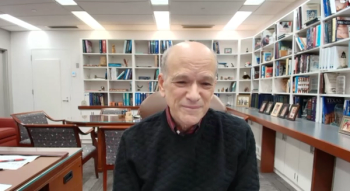
The Science and Politics of PTSD
The first half of the 20th century saw 2 world wars, indiscriminate aerial bombing of civilians, the dropping of the atomic bomb, and the Holocaust-all of which created intense trauma for soldiers and civilians.Yet it was not until the American intervention in a post-colonial civil war in Southeast Asia that the psychiatric community in the 1970s formally described what we now call PTSD.
The first half of the 20th century saw 2 world wars, indiscriminate aerial bombing of civilians, the dropping of the atomic bomb, and the Holocaust-all of which created intense trauma for soldiers and civilians. Yet it was not until the American intervention in a post-colonial civil war in southeast Asia that the psychiatric community in the 1970s formally described what we now call PTSD. Grinker and Spiegel, American psychiatrists, published War Neurosis in North Africa: The Tunisian Campaign1 in 1943 and, in 1945, Men Under Stress,2 which addressed the impact of stress on members of the American Army Air Corps. In some ways their accounts serve as a forerunner of later work on PTSD.
Here, I review factors that led to the codification during the Vietnam War of the symptoms and behaviors that today constitute the diagnosis of PTSD. I also examine the factors that delayed the process of identifying this disorder to well after the major global upheavals of the first half of the 20th century.
Developing diagnostic criteria for PTSD
A major element that affected the development of the diagnosis of PTSD was the response of the American public to the Vietnam War in the 1960s and 70s. Although the US had a military draft, the soldiers sent to Vietnam were overwhelmingly from lower socioeconomic groups and minorities. Minorities and the poor bore much of the burden of the war in Vietnam These and other realities gave rise to major antiwar demonstrations by civilians and broad antimilitary campaigns. Concurrently, high incidences of substance abuse were observed in American soldiers in Vietnam and in other US military bases. The substance abuse and other mental health disturbances continued after the soldiers returned home.
The US government wanted and needed an explanation as to why the psychiatric morbidity of Vietnam War veterans exceeded that seen in veterans of World War II and the Korean War. In response, the psychiatric community created the diagnosis of PTSD to account for the behaviors and symptoms observed in veterans who experienced extreme trauma.
It proved difficult, however, to establish clarity and uniqueness for the diagnosis of PTSD. Coexisting substance abuse and symptoms of depression and anxiety blurred the boundaries between these disorders and PTSD. For Vietnam war veterans and all US military veterans, these distinctions are critical. A diagnosis of PTSD entitles veterans to lifelong pensions, whereas a diagnosis of substance disorders does not.
Etiological factors in PTSD
Adding to the difficulty of assessing an individual for the presence of PTSD are the complex factors that determine who is at risk for the disorder and why traumatic events that trigger symptoms and behaviors in one soldier do not in another. The interaction of an individual’s genetics, psychology and life experiences partially determines his or her responses to severe stress and affects the likelihood that PTSD will develop.
The social context in which an individual lives and works also affects his psychological organization and may either support or impair mechanisms in dealing with stress. The soldier in a unit with members with whom he has trained may experience their camaraderie as supportive. Shared psychological experiences may be internalized in a manner that enhances his ability to deal with combat stress without long-term adverse psychological sequelae. The soldier who has not had shared experiences of trust before combat may feel isolated and more vulnerable during combat, which may make him more vulnerable to PTSD.
Broader societal factors may also contribute either positively or negatively to the development of combat-related PTSD. The morale of the country and its support for a military action may provide a positive background for soldiers, which may be integrated into a psychological system that serves to protect them from PTSD. During the Vietnam war, many American soldiers did not feel supported by the country at large. The lack of accretion of all these elements by American soldiers in Vietnam may have contributed to their being more psychologically vulnerable to develop PTSD than were soldiers of previous wars.
Factors in PTSD treatment
Because of the frequent co-occurrence of PTSD with other mental health problems, it is not surprising that the Institute of Medicine of the National Academy of Sciences3 could not categorically support a specific treatment for PTSD. This does not mean that a given treatment will be ineffective but rather that evidence for proof of efficacy is not available.
Another difficulty in developing therapies for PTSD is that similar symptoms and behaviors may have quite different causal factors, while different symptom patterns may have common causal factors. A required outcome in treating PTSD is that an individual’s psychological mechanisms for maintaining homeostasis are restored. In the absence of a clear understanding of the causal factors responsible for the patient’s symptoms and behavior, it may be difficult to develop effective treatment.
With many psychiatric disorders, we do not know-- other than through information supplied by the patient -- what overwhelmed the patient’s psychological system. As we address the patient’s self-reported experiences, we develop inferences regarding the reported stressors and their effects and develop therapeutic interventions based on our understanding.
With PTSD, the nature of the stress may be explicit; however, knowledge of the patient’s inner life is not. It may be just as important in developing a treatment strategy for a patient with PTSD as it is for other disorders to learn about the patient’s coping strategies and defenes. This knowledge must include an essential understanding of how the patient dealt with stress before the diagnosis of PTSD. Information on comorbid psychiatric disorders and/or medical illness must also be gathered to complete a comprehensive diagnostic assessment and make treatment decisions.
Why it took so long to identify the diagnosis
So: why was PTSD first explicitly described during the Vietnam war? In World War II, pain, suffering, and trauma were seen as natural outcomes of the war. Complaints were viewed as signs of weakness and fear. Focusing on fear as a response to the trauma of war would run the risk of contagion among soldiers or civilians that might leave them unable to endure further stress.
In the Battle of Britain, it was critical for Britain to sustain both military and civilian morale. This required that British leaders communicate a resolve to both the British people and German leaders that Britain would eventually prevail. In that context, there was no room for PTSD. Throughout Europe, bombing of civilian populations brought the same suffering and trauma-everyone experienced the trauma of war.
Understanding the trauma experienced by the victims of the Holocaust-trauma beyond that of the war itself-would have seemed a likely arena in which to define the syndrome. The stories of many Holocaust survivors clearly demonstrate that they suffered from PTSD. But the intensity of the horror and the failure of governments to respond to protect millions of fellow Europeans may have obscured the full impact of the trauma on survivors. In the end, neither psychiatry nor society effectively examined the long-term effects of trauma on the survivors of the Holocaust or survivors of World War II.
During the Vietnam War, the general lack of support and the perception that the outcome of the war did not have any relevance to the security of the US allowed a closer look at the soldiers’ experience of war. With the focus on individual soldiers and their experiences, rather than on the mission or the morale of the country, the ordeal that soldiers faced became the impetus for identifying PTSD and developing treatment programs.
Conclusion
Once a veteran’s dysfunction is understood as a unique response to the horrors of war, it can be addressed and special programs can be implemented to help him or her return to full functioning in society. Special courts to address the needs of veterans as reported in The New York Times are one example.4
The Institute of Medicine of the United States National Academy of Science has commissioned a further review of PTSD, with a goal of clarifying the benefits of a number of therapies. Because of the complexity of how stressors may lead to PTSD, many treatment strategies are needed to provide the best outcomes for patients.
References1. Grinker RR, Spiegel JP. War Neurosis in North Africa: The Tunisian Campaign. (January-May 1943). New York: Josiah Macy, Jr, Foundation; 1943.
2. Grinker RR, Spiegel JP. Men Under Stress. Philadelphia: Blakiston; 1945.
3. Board on Population Health and Public Health Practice. Treatment of Post Traumatic Stress Disorder: An Assessment of the Evidence. Washington, DC: National Academies Press; 2008.
4. Goode E. Coming together to fight for a troubled veteran. New York Times. July 17, 2011.
Newsletter
Receive trusted psychiatric news, expert analysis, and clinical insights — subscribe today to support your practice and your patients.

















